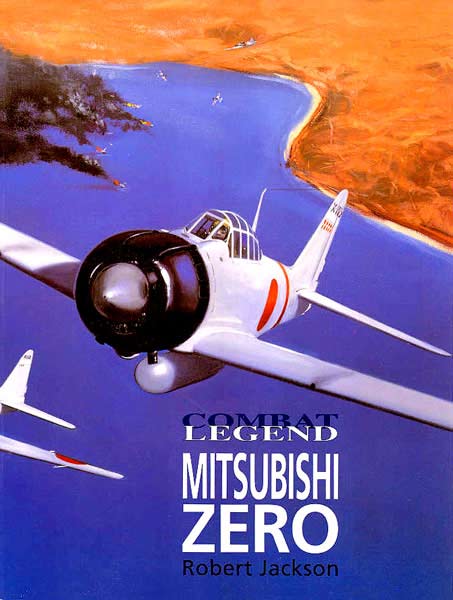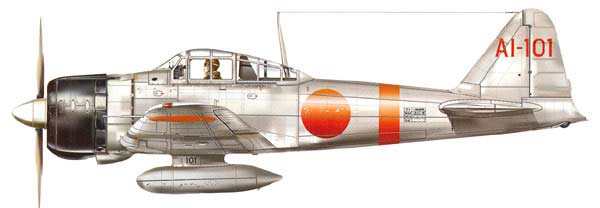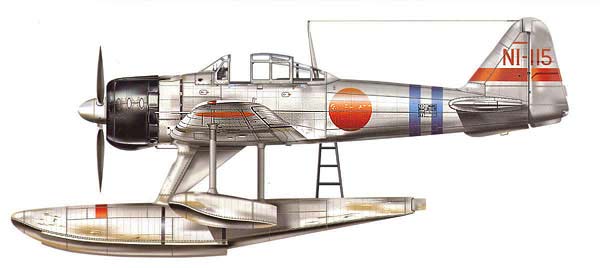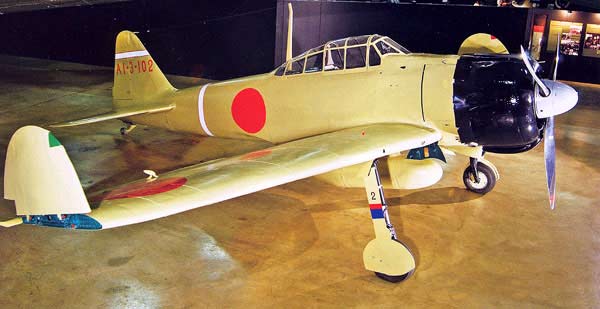BOOK REPORT
MITSUBISHI ZERO - COMBAT LEGEND
 Publisher: The Crowood Press LTD. Author: Robert Jackson |
| 16 Beautiful color profile illustrations by Dave Windle |

The above illustration is a Mitsubishi Zero Model 21 A6m2 of The Akagi Carrier Group.

This beautiful illustration above is a Nakajima A6m2-N Type 2 Fighter Seaplane
In late 1941 and early 1942, Zero fighters flying from carriers or land bases, wrought havoc over Pearl Harbor, the Philippines, Singapore and other targets in the Pacific. When the tide of war turned against the Japanese, Zero pilots died by the hundreds in air battles or Kamikaze attacks on the advancing American forces. When first adopted into service in 1940, the Zero was equal to other fighter in service throughout the world and better than most. It first saw action over the Chinese mainland in 1940 and served throughout the Pacific war. Over 10,430 aircraft were built, more than any other aircraft built in Japan. In the latter stages of the war the American Hellcat and P-38 Lightning eventually outclassed the Zero.

MITSUBISHI A6M2 ZERO ( ZEKE ) Ctsy. A.F. MUSEUM
This publication is an encyclopedia on the Japanese Zero. It covers the path of evolution that led to the Mitsubishi Zero, one of the most remarkable fighter aircraft of all time. It began in June 1912, when a Navy Aeronautical Research Committee was set up by the Imperial Japanese Navy. They sent six officers to France and the United States, with orders to purchase a number of seaplanes, which they were to learn to fly and maintain. In November of that year, a small Naval Air Base was established on the coast near Yokosuka where a small number of Naval Officers received flight and technical training. In 1921 construction began on the first Japanese aircraft carrier. An embryo aircraft industry saw the establishment of Kawasaki, Mitsubishi, and Nakajima. Many different types of aircraft were developed through the years, with the big three experimenting with aircraft and engine design, special alloys, and armament. Finally on 14 Sept. 1939 the Imperial Japanese Navy officially accepted the A6M1 Type 0 Carrier Borne Fighter. In 1940 zeros were sent to China to perform in actual combat conditions. The Zero fighter quickly established total air supremacy in the China theatre.
Final preparations for the attack on Pearl Harbor began on 22 Nov. 1941. The fleet sailed on 26 Nov. The first attack wave began on 7 Dec. There were 79 Zeros deployed, of which 15 were lost. There were 384 aircraft on the islands: 188 were destroyed and 159 damaged, 18 of the 94 warships in Pearl Harbor were sunk or suffered major damage, eight of those were battleships.
This book covers in detail the Battle of Midway, and the air fighting in the Solomons. A very interesting section follows that compares the combat capability of the Zero against the Wildcat, the F6F Hellcat and the Lockheed P-38. Also covered is the Battle of the Philippine Sea, and the Battle of Leyte Gulf in which the Japanese launched a new and terrifying weapon: the Kamikaze suicide attacks. These would continue through the Battle of Okinawa and against the B-29s over Japan. More Zeros were used in these attacks than any other type. The Japanese, starved of fuel, now under attack by carrier aircraft as well as B-29 bombers, prepared Massive Kamikaze attacks to sacrifice themselves in a last-ditch suicide mission against the expected Allied invasion. The Atomic bombing of Hiroshima and Nagasaki ended the war, and the massive loss of life the invasion would have caused never happened.
A very interesting section covers Japans top aces. There definitely was a tendency for the Japanese pilots to exaggerate the number of kills, and there is uncertainty as to the actual count. This section covers leading aces with stories of their exploits. The best known Japanese Air Ace was Lt. (JG) Saburo Sakai. He was the author of Samurai, a book about his exploits, which was translated into several languages. His official score is 64 against aircraft destroyed.
Performance comparisons of the Zero against the Airacobra, Zero versus the P-51 Mustang, and Zero versus the Spitfire are most informative. Air superiority in the Pacific was severely affected by the dire pilot shortage suffered by Japan. The constant massive attacks by U.S. aircraft had created a dwindling band of Japanese Aces.
The final section of the book covers versions and variants plus engine specifications. Also the beautiful color plates of the many different models. Appendix one through six covers technical descriptions, weapons systems, production numbers, Zero units, carrier and land based, museum aircraft, and even model kits available.
I give this book five stars, as it definitely covers everything anyone needs to know about the Combat Legend, the Mitsubishi Zero.
Book report written by Wayland Mayo, Website Historian